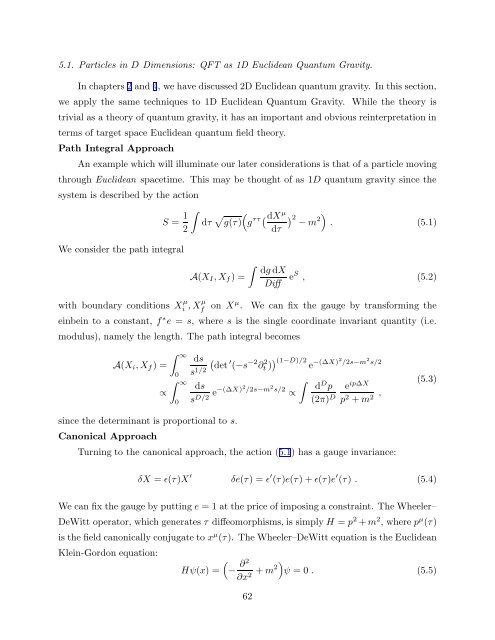arXiv:hep-th/9304011 v1 Apr 5 1993
arXiv:hep-th/9304011 v1 Apr 5 1993
arXiv:hep-th/9304011 v1 Apr 5 1993
You also want an ePaper? Increase the reach of your titles
YUMPU automatically turns print PDFs into web optimized ePapers that Google loves.
5.1. Particles in D Dimensions: QFT as 1D Euclidean Quantum Gravity.<br />
In chapters 2 and 4, we have discussed 2D Euclidean quantum gravity. In <strong>th</strong>is section,<br />
we apply <strong>th</strong>e same techniques to 1D Euclidean Quantum Gravity. While <strong>th</strong>e <strong>th</strong>eory is<br />
trivial as a <strong>th</strong>eory of quantum gravity, it has an important and obvious reinterpretation in<br />
terms of target space Euclidean quantum field <strong>th</strong>eory.<br />
Pa<strong>th</strong> Integral Approach<br />
An example which will illuminate our later considerations is <strong>th</strong>at of a particle moving<br />
<strong>th</strong>rough Euclidean spacetime. This may be <strong>th</strong>ought of as 1D quantum gravity since <strong>th</strong>e<br />
system is described by <strong>th</strong>e action<br />
S = 1 2<br />
We consider <strong>th</strong>e pa<strong>th</strong> integral<br />
∫<br />
dτ √ g(τ)<br />
(g ττ ( dX µ ) ) 2<br />
− m<br />
2<br />
. (5.1)<br />
dτ<br />
A(X I , X f ) =<br />
∫ dg dX<br />
Diff eS , (5.2)<br />
wi<strong>th</strong> boundary conditions X µ i , Xµ f on Xµ . We can fix <strong>th</strong>e gauge by transforming <strong>th</strong>e<br />
einbein to a constant, f ∗ e = s, where s is <strong>th</strong>e single coordinate invariant quantity (i.e.<br />
modulus), namely <strong>th</strong>e leng<strong>th</strong>. The pa<strong>th</strong> integral becomes<br />
A(X i , X f ) =<br />
∝<br />
∫ ∞<br />
0<br />
∫ ∞<br />
since <strong>th</strong>e determinant is proportional to s.<br />
Canonical Approach<br />
0<br />
ds (<br />
det ′ (−s −2 ∂ 2<br />
s 1/2 t ) ) (1−D)/2<br />
e<br />
−(∆X) 2 /2s−m 2 s/2<br />
∫<br />
ds<br />
/2s−m 2 s/2 d D p<br />
∝<br />
s D/2 e−(∆X)2 (2π) D<br />
e ip∆X (5.3)<br />
p 2 + m , 2<br />
Turning to <strong>th</strong>e canonical approach, <strong>th</strong>e action (5.1) has a gauge invariance:<br />
δX = ɛ(τ)X ′ δe(τ) = ɛ ′ (τ)e(τ) + ɛ(τ)e ′ (τ) . (5.4)<br />
We can fix <strong>th</strong>e gauge by putting e = 1 at <strong>th</strong>e price of imposing a constraint. The Wheeler–<br />
DeWitt operator, which generates τ diffeomorphisms, is simply H = p 2 + m 2 , where p µ (τ)<br />
is <strong>th</strong>e field canonically conjugate to x µ (τ). The Wheeler–DeWitt equation is <strong>th</strong>e Euclidean<br />
Klein-Gordon equation:<br />
Hψ(x) =<br />
(− ∂2<br />
∂x 2 + m2 )<br />
ψ = 0 . (5.5)<br />
62
















